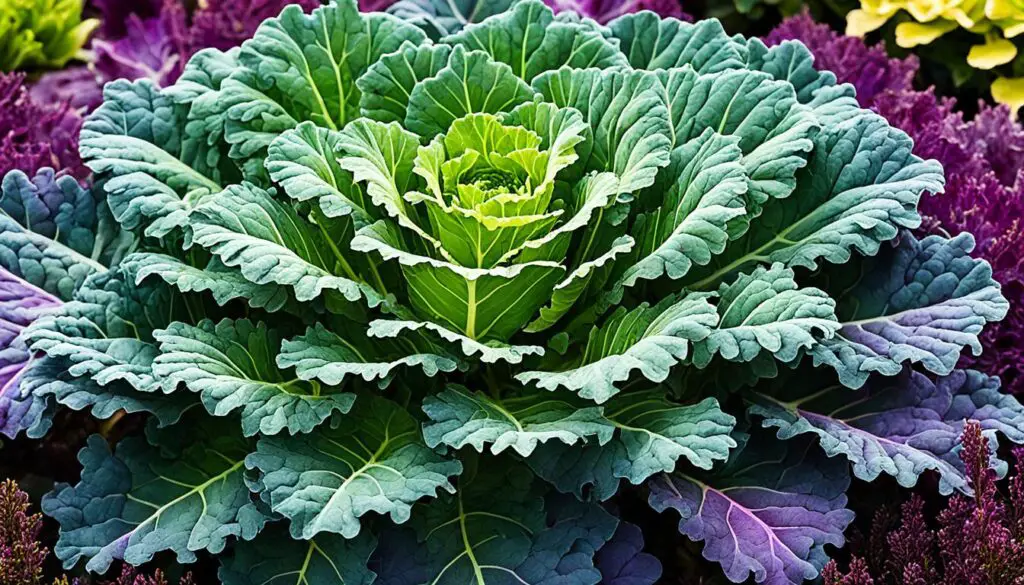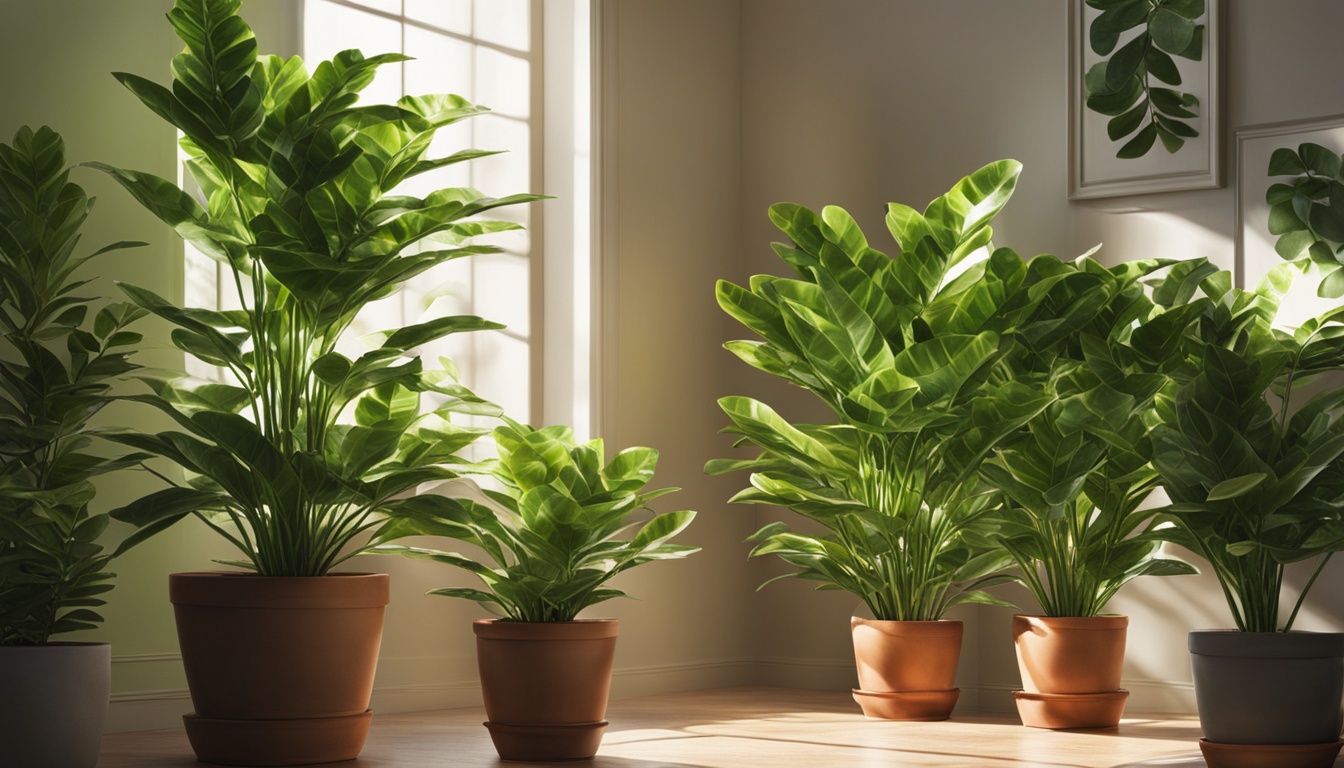Ornamental kale is known for its vibrant leaves in colors like pink, purple, and red. It’s easy to grow and adds beauty to containers and garden beds. This plant belongs to the same family as cabbage, cauliflower, and broccoli.
It loves cool weather and shines in spring and fall. Ornamental kale is tough and can handle light frost. It stays beautiful through winter in USDA Zones 8 and above.

You can plant ornamental kale in early spring or fall when it gets cold at night. If you want to see it for a few weeks, buying big plants is a good idea. Or, you can grow your own from seeds for a personal touch.
Key Takeaways
- Ornamental kale is a vibrant, cool-weather annual perfect for spring and fall gardens.
- It thrives in full sun and well-drained, slightly acidic soil.
- Ornamental kale comes in a variety of striking foliage colors and patterns.
- Start seeds indoors 4-6 weeks before transplanting outside for best results.
- Proper watering and balanced fertilization are key to maintaining ornamental kale’s colorful display.
Ornamental Kale Plants: A Vibrant Addition to Your Garden
Varieties and Colors
Ornamental kale plants, or Brassica oleracea, add a pop of color to gardens. They were bred for their looks, not their taste. These plants don’t really flower much. Their beauty comes from their fancy leaves.
Ornamental kales come in two main types. The “fringed-leaved” ones have curly edges, while the “feather-leaved” ones have fine cuts.
Favorites include the ‘Chidori’ with its curly leaves, ‘Color Up’ with green leaves and colorful centers, ‘Osaka’ with big leaves and heart-shaped colors, and ‘Peacock’ with its deep cuts and red, purple, or white colors.
| Ornamental Kale Variety | Leaf Characteristics | Color Palette |
|---|---|---|
| ‘Chidori’ | Very curly leaf edges | Wide range of colors |
| ‘Color Up’ | Green leaves with colored centers | Pink, white, fuchsia |
| ‘Osaka’ | Large, smooth leaves | Pink, red, white |
| ‘Peacock’ | Loose growth, deeply serrated | Red, purple, white |
The colors of ornamental kale get brighter in the cold. They turn white, pink, blue-green, purple, and show off bi-colors as it gets colder. These plants are great for winter, adding color to gardens and floral designs.
Grow An Ornamental Kale and Care: Planting and Growing Conditions
Ornamental kale adds a bold and vibrant touch to any fall garden. It’s easy to grow from seed or seedlings. Just follow a few key steps to make sure your ornamental kale does well.
Starting with seeds, remember they need light to grow. Just spread them on the soil in pots or flats. They will sprout in 3 to 5 days. For a fall harvest, start your seeds by the first of July.
Ornamental kale loves full sun and rich, well-drained soil. The ideal pH is between 5.8 and 6.5. It grows best in cool weather, so plant it when fall arrives. In USDA zones 2-11, it can even survive at 5°F with some acclimation.
When moving seedlings, put them 18 to 24 inches apart. This lets them grow well. Thin them out when they’re 3 inches tall to help the strongest plants grow bigger.

Ornamental kale does best in cool weather. The leaves look their best when it’s under 60°F. It can handle full or partial sun but not hot weather. Hot weather makes the stems long and the leaves fade.
Knowing the best conditions for ornamental kale helps you create a beautiful fall garden. This will make your garden look great into the cooler months.
Caring for Your Ornamental Kale Plants
Watering and Fertilizing
Keeping your ornamental kale plants healthy is key. Make sure they don’t get too dry. They need about an inch of water each week. But, don’t overwater to avoid problems.
Don’t overfeed your kale. It doesn’t need a lot of food. A light fertilizer at planting time is enough. Avoid too much nitrogen, as it can harm the colors and make the stems too long.
Keep your kale looking great by removing flower stems. This stops the plant from focusing on flowers and keeps the leaves colorful. With proper care, your kale will be a beautiful addition to your garden.
Managing Pests and Diseases
Ornamental kale can face pests and diseases. But, you can keep your plants healthy with the right steps. Watch out for cabbage worms, flea beetles, and aphids. Use insecticidal soaps or sprays to control them.
Leaf spots can happen, especially in damp places. Good air flow and avoiding overhead watering can help. If you see disease, treat it with fungicides right away.
Stay alert and treat pests and diseases fast. This way, your ornamental kale will stay colorful and last longer.

Ornamental Kale: Pests, Diseases, and Winter Hardiness
As a gardener, I’ve found ornamental kale to be quite challenging. It faces threats from pests and diseases, similar to its Brassica relatives.
Pests like cabbage worms, flea beetles, and aphids can damage these plants. But, with the right strategies, I’ve managed to keep my ornamental kale pest-free and healthy.
To keep pests away, I use a hard water spray to remove them from the leaves. Pesticide dusts or horticultural oils also work well on these pests. For diseases, ensuring the plants have good drainage helps prevent issues like leaf spots and blackleg.
Ornamental kale is quite hardy in the cold, but it depends on the weather. Hot, long days can cause them to bolt and seed.
Heavy rain or storms can also damage them. Yet, if the temperature stays above 5 degrees Fahrenheit, they usually survive. With careful attention, I’ve enjoyed my ornamental kale even in the cold months.
FAQ
What makes ornamental kale plants unique?
Ornamental kale, also known as flowering kale, is known for its stunning, ruffled leaves. These leaves come in bright colors like pinks, purples, and reds. It’s grown for its looks, not for eating.
What are some popular varieties of ornamental kale?
Popular varieties include ‘Chidori’ with curly leaves and ‘Color Up’ with green leaves and colorful centers. ‘Osaka’ has big, smooth leaves with pink, red, or white centers. ‘Peacock’ has deep-serrated leaves in red, purple, or white. The ‘Pigeon’ series has flat leaves with red or white centers.
When is the best time to plant ornamental kale?
The best times to plant ornamental kale are early spring and fall, when it gets cold at night. You can start from seeds or buy started plants.
What are the ideal growing conditions for ornamental kale?
Ornamental kale loves full sun and rich, well-drained soil that’s a bit acidic. It needs cool weather to show off its best colors. Hot weather can make the leaves fade and stems get too long.
How do I care for my ornamental kale plants?
Keep your plants watered and don’t overfeed them. Cut off any flower stems right away. Watch out for pests like cabbage worms and aphids, and diseases that like dampness. Good air flow is key.
How long will ornamental kale last in the garden?
Ornamental kale can last through winter, but how it looks depends on the weather. It can handle light frost but extreme cold, heat, or heavy rain can harm it.



